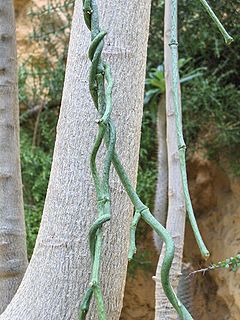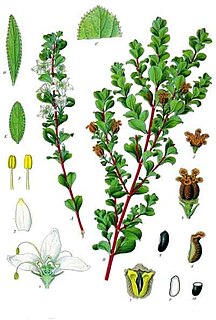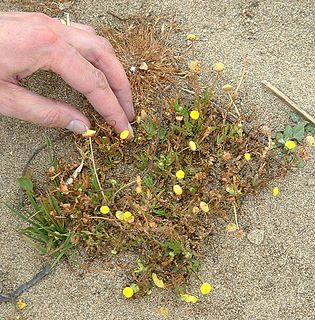
Portulaca (, is the type genus of the flowering plant family Portulacaceae, with over 100 species, found in the tropics and warm temperate regions. They are known as the purslanes.

The Amaranthoideae are a subfamily of the Amaranthaceae. The stamens have anthers with two lobes (locules) and four pollen sacs. The main distribution of the subfamily is in tropical America, in tropical and Southern Africa, and in Australia.

Typhonium is a genus in the family Araceae native to eastern and southern Asia, New Guinea, and Australia. It is most often found growing in wooded areas.
- Typhonium acetosellaGagnep. - Cambodia, Laos, Thailand, Vietnam
- Typhonium adnatumHett. & Sookch. - Thailand
- Typhonium albidinerviumC.Z.Tang & H.Li - Guangdong, Hainan, Laos, Thailand
- Typhonium albispathumBogner - Thailand
- Typhonium alismifoliumF.Muell. - Queensland, Northern Territory
- Typhonium angustilobumF.Muell. - Queensland, New Guinea
- Typhonium bachmaenseV.D.Nguyen & Hett. - Vietnam
- Typhonium baoshanenseZ.L.Dao & H.Li - Yunnan
- Typhonium blumeiNicolson & Sivad. - Japan, Taiwan, Ryukyu Islands, much of China, Bangladesh, Laos, Cambodia, Myanmar, Thailand, Vietnam; nautralized in Madagascar, Mauritius, Comoros, Borneo, Philippines, West Indies
- Typhonium bognerianumJ.Murata & Sookch. - Thailand
- Typhonium browniiSchott - Queensland, New South Wales
- Typhonium bulbiferumDalzell - southern India
- Typhonium circinnatumHett. & J.Mood - Vietnam
- Typhonium cochleareA.Hay - Bangladesh, Northern Territory of Australia
- Typhonium cordifoliumS.Y.Hu - Thailand
- Typhonium digitatumHett. & Sookch. - Thailand
- Typhonium echinulatumHett. & Sookch. - Thailand
- Typhonium eliosurum(F.Muell. ex Benth.) O.D.Evans - New South Wales
- Typhonium filiformeRidl. - Thailand, Malaysia
- Typhonium flagelliforme(G.Lodd.) Blume - Guangdong, Guangxi, Yunnan, Bangladesh, Bhutan, Cambodia, India, Indonesia, Laos, Malaysia, Myanmar, Philippines, Singapore, Sri Lanka, Thailand, New Guinea, Queensland, Northern Territory
- Typhonium fultumRidl. - Thailand, Malaysia
- Typhonium gagnepainiiJ.Murata & Sookch. - Thailand, Cambodia
- Typhonium gallowayiHett. & Sookch. - Thailand
- Typhonium glaucumHett. & Sookch. - Thailand
- Typhonium griseumHett. & Sookch. - Thailand
- Typhonium hayataeSriboonma & J.Murata - Vietnam
- Typhonium huenseNguyen & Croat - Vietnam
- Typhonium hunanenseH.Li & Z.Q.Liu - Hunan
- Typhonium inopinatumPrain - India, Myanmar, Thailand
- Typhonium jinpingenseZ.L.Wang, H.Li & F.H.Bian - Yunnan
- Typhonium johnsonianumA.Hay & S.M.Taylor - Northern Territory of Australia
- Typhonium jonesiiA.Hay - Northern Territory of Australia
- Typhonium laoticumGagnep. - Thailand, Laos
- Typhonium liliifoliumF.Muell. ex Schott - Northern Territory, Western Australia
- Typhonium lineareHett. & V.D.Nguyen - Vietnam
- Typhonium listeriPrain - Assam, Bangladesh, Myanmar
- Typhonium medusaeHett. & Sookch. - Thailand
- Typhonium mirabile(A.Hay) A.Hay - Melville Island of Australia
- Typhonium neogracileJ.Murata - Assam, Bangladesh, Myanmar
- Typhonium nudibaccatumA.Hay - Western Australia
- Typhonium orbifoliumHett. & Sookch. - Thailand
- Typhonium pedatisectumGage - Myanmar
- Typhonium pedunculatumHett. & Sookch. - Thailand
- Typhonium peltandroidesA.Hay, M.D.Barrett & R.L.Barrett - Western Australia
- Typhonium penicillatumV.D.Nguyen & Hett. - Vietnam
- Typhonium pottingeriPrain - Myanmar
- Typhonium praecoxJ.Murata - Myanmar
- Typhonium praetermissumA.Hay - Northern Territory of Australia
- Typhonium pusillumSookch., V.D.Nguyen & Hett. - Thailand
- Typhonium reflexumHett. & Sookch. - Thailand
- Typhonium roxburghiiSchott - Taiwan, Yunnan, Bonin Islands, India, Bangladesh, Sri Lanka, Andaman Islands, Thailand, Malaysia, western Indonesia, Philippines, New Guinea; naturalized in Western Australia, eastern Brazil, Tanzania
- Typhonium russell-smithiiA.Hay - Northern Territory of Australia
- Typhonium sagittariifoliumGagnep. - Thailand
- Typhonium saraburiensisSookch., Hett. & J.Murata - Thailand
- Typhonium sinhabaedyaeHett. & A.Galloway - Thailand
- Typhonium smitinandiiSookch. & J.Murata - Thailand
- Typhonium stigmatilobatumV.D.Nguyen - Vietnam
- Typhonium subglobosumHett. & Sookch. - Thailand
- Typhonium tayloriiA.Hay - Northern Territory of Australia
- Typhonium trifoliatumF.T.Wang & H.S.Lo ex H.Li, Y.Shiao & S.L.Tseng - Mongolia, Hebei, Inner Mongolia, Shaanxi, Shanxi
- Typhonium trilobatum(L.) Schott - southern China, Indian Subcontinent, Indochina; naturalized in Windward Islands, Ivory Coast, Borneo, Philippines
- Typhonium tubispathumHett. & A.Galloway - Thailand
- Typhonium variansHett. & Sookch. - Thailand
- Typhonium vermiformeV.D.Nguyen & Croat - Vietnam
- Typhonium violifoliumGagnep. - Myanmar, Thailand
- Typhonium watanabeiJ.Murata, Sookch. & Hett. - Thailand
- Typhonium weipanumA.Hay - Queensland
- Typhonium wilbertiiA.Hay

Cynanchum is a genus of about 300 species including some swallowworts, belonging to the family Apocynaceae. The taxon name comes from Greek kynos and anchein, hence the common name for several species is dog-strangling vine. Most species are non-succulent climbers or twiners. There is some evidence of toxicity.

Livistona is a genus of palms, the botanical family Arecaceae, native to southeastern and eastern Asia, Australasia, and the Horn of Africa. They are fan palms, the leaves with an armed petiole terminating in a rounded, costapalmate fan of numerous leaflets.

Calandrinia are a large genus of flowering plants known as purslanes and redmaids. It includes over 100 species of annual and perennial herbs which bear colorful flowers in shades of red to purple and white. Plants of this genus are native to Australia, western South America, Central America, and western North America. Some species have been introduced to parts of New Zealand, southern Africa, Asia, and Europe.

Agathosma is a genus of about 140 species of flowering plants in the family Rutaceae, native to the southern part of Africa. Common names include Buchu, Boegoe, Bucco, Bookoo and Diosma. Buchu formally denotes two herbal species, prized for their fragrance and medicinal use despite their toxicity. In colloquial use however, the term is applied to a wider set of fragrant shrubs or substitutes.

Centrolepis is a genus of small herbaceous plants in the family Restionaceae known as thorn grass scales, with about 25 species native to Australia, New Zealand, New Guinea, and south-east Asia as far north as Hainan Dao. APG III system classifies this genus in the Centrolepidaceae family.

Cotula is a genus of flowering plant in the sunflower family. It includes plants known generally as water buttons or buttonweeds.

Aneilema is a genus of monocotyledonous plants of approximately 60 species. The vast majority of the species are native to sub-Saharan Africa, but a few are found in Oceania and one, Aneilema brasiliense, is from South America. It is the third largest genus in the family Commelinaceae after Commelina and Tradescantia, and it is one of only six genera in the family to occur in both the Eastern Hemisphere and the Western Hemisphere.

Enteropogon is a genus of tropical and subtropical plants in the grass family. It is widespread across many parts of Asia, Africa, Australia, the Americas, and various islands.

Dicrastylis is a genus of plants in the Lamiaceae, first described in 1855. The entire genus is endemic to Australia. The type species is Dicrastylis fulva.

Spartothamnella is a genus of flowering plants in the mint family, Lamiaceae, first described with this name in 1894 by John Isaac Briquet. The entire genus is endemic to Australia

Haemodorum is a genus of herbs in the family Haemodoraceae, first described as a genus in 1798 by James Edward Smiith. The genus is native to New Guinea and Australia. The type species is Haemodorum corymbosum Vahl, first described by Martin Vahl in 1805.
Hypertelis is a genus of flowering plants in the family Molluginaceae. Most of its former species have been transferred to the new genus Kewa, and the remaining species, Hypertelis spergulacea, may also need a different placement. Hypertelis spergulacea is a woody-based plant, up to 30 cm (1 ft) high, with whorled greyish green leaves. It is found on the border between Namibia and the Northern Cape province of South Africa.
Chascanum is a genus of flowering plants belonging to the family Verbenaceae.















